
Personal Identification from Dental Findings Using AI and Image Analysis against Great Disaster in Japan
*Corresponding Author(s):
Takano HDepartment Of Oral Management Center, Tokushima University Hospital, Tokushima, Japan
Tel:+81 886337352,
Email:takano@tokushima-u.ac.jp
Abstract
The Great East Japan Earthquake that occurred in Japan in 2011 resulted in tremendous damage, with 15,897 dead and 2,533 missing. To confirm the identity of the victims, approximately 2,600 dentists have collected approximately 8,750 dentistry findings. From the dental findings, the identity of 1,250 bodies was found, but the work required a great deal of time and effort.
The Nankai Trough Earthquake is predicted to occur in the near future, but the victim’s maybe about 20 times as large as the Great East Japan Earthquake, and it will be necessary to greatly increase the efficiency and speed of identification. Therefore, in Japan, efforts are being made to save findings in a database using Standard code, such as automatic analysis of intraoral photographs and 3D data, and automatic diagnosis of panoramic X-ray photographs using Artificial Intelligence (AI).
Keywords
Artificial intelligence; Automated diagnostics; Forensic dentistry; Nankai through earthquake
INTRODUCTION
Identification by dental findings during a large-scale disaster in japan
In Japan, the identification of teeth from a tooth during a large-scale disaster became widely known because of a passenger air craft crash in 1985. In the crash, 520 out of 524 passengers and crew were killed. Among them, the importance of 43% of corpses was confirmed by dental findings [1,2] and its importance was widely known to the general public.
GREAT EAST JAPAN EARTHQUAKE
In Japan, the Great East Japan Earthquake occurred on March 11, 2011. The magnitude was 9.0, and after the earthquake, a huge tsunami rushed to the coast of the Tohoku region, causing serious damage to 15,897 dead and 2,531 missing [3]. Of these, 13,956(88.6%) people were identified by physical characteristics and belongings. Dental evidence identified 1,250(7.9%), 173(1.1%) DNA, and 373(2.4%) fingerprints / palm prints. A total of 2,600 dentists gathered from all over the country were engaged in this confirmation work, and the findings of about 8,750 bodies were collected. However, in addition to a large number of victims, the dentist's medical records and radiographs were washed away by the tsunami, and this collation was extremely difficult [4] Nankai Trough earthquake.
In Japan, a huge earthquake with an epicenter of the Nankai Trough is predicted to occur with a probability of 70-80% within the next 30 years. The victims of the massive earthquake are estimated to reach up to 320,000, which is 20 times the victims of the Great East Japan Earthquake. There is a high possibility that this conventional method that focuses on manual operations cannot be used to confirm the victim's identity and significant efficiency and speedup by digitalization is required. To that end, digitization of prenatal data, digitization of a Collection of corpse findings is considered necessary.
DIGITIZATION OF PREMORTEM DATA
Due to the Great East Japan Earthquake, it was difficult to collect medical records and X-ray photographs, etc. due to the collapse and outflow of dental care facilities caused by tsunamis. The Ministry of Health, Labor and Welfare stated in 2013-2016, reflecting on the fact that the collected electronic medical record data and paper medical records have various formats and contents for each dental medical institution and had to be re-entered into a unified format. Conducted a demonstration project on the standardization of dental information. Through this project, the Japan Dental Association Oral Examination Standard code (JDAOES) was formulated as a common code for unifying the display format of dental care information in Japan and outputting it from a receipt computer. Since 2017, the “Dental Information Utilization and Standardization Dissemination Project” has been carried out as a successor project, and model projects are being conducted in Shizuoka, Niigata, Oita, and Wakayama Prefectures. Following these achievements, we are planning to participate in this project in the future.
Digitization of dental findings by image analysis of intraoral photographs
It is also necessary to digitize work in order to improve the efficiency and speed of corpse finding records at the time of the disaster. Therefore, in collaboration with the laboratory of Professor Kenji Terada of the Department of Intelligent Information Engineering, Tokushima University. We created an application that automatically analyzes dental findings from intraoral photographs by image analysis and outputs them in the oral examination standard code (Figure 1). The analysis results are registered in the database after being checked and corrected by the dentist. As a result, collection and recording of intraoral findings are dramatically improved and expedited [5].
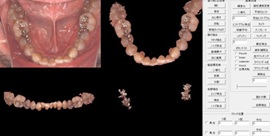
Figure 1: Image analysis of intraoral photograph.
Digitization of dental findings by intraoral 3D data analysis
In the case of a corpse, the amount of opening may be insufficient, and an intraoral photograph in a good condition suitable for automatic image analysis may not be taken. Therefore, we are currently creating an application to analyze 3D data collected using an intraoral scanner (Figure 2).
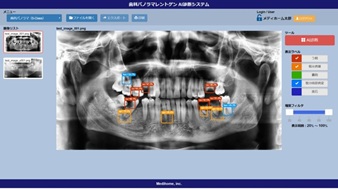
Figure 2: AI Diagnostics for X-Ray.
AUTOMATIC ANALYSIS AND DATA REGISTRATION BY AI FROM PANORAMIC RADIOGRAPHS
X-ray findings also play an important role in identity verification. Comparison of pre- and post-mortem image data is often the decisive factor for identification, but saving image data to the database also has storage capacity issues, so X-ray findings are output to the oral examination standard code and stored in the database. For this item, we cooperated with MediHome, which has X-ray diagnostic technology using AI. In the diagnostic software User interface, when a medical image to be diagnosed is read, the disease name, certainty factor, etc. are displayed along with the mark at the location where the lesion is detected (Figure 3). Currently, diagnosable lesions are assumed to be caries and apical lesions, but we plan to increase the number of lesions that can be diagnosed as needed.
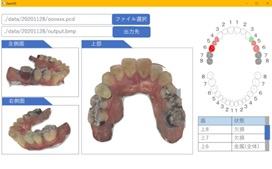
Figure 3: Analysis of intraoral 3D data.
EHR NETWORK IN JAPAN
Currently, in Japan, the Ministry of Internal Affairs and Communications, the Ministry of Health, Labor and Welfare, and the Ministry of Economy, Trade and Industry are leading the way to promote Electronic Health Records (EHR). EHR is used to share medical / health information among relevant persons such as the person and medical workers while reducing the burden on patients and medical institutions, as well as providing a stable supply of regional medical care and improving the quality of medical care. Furthermore, it is expected to contribute to the optimization of medical expenses. Also, in the Great East Japan Earthquake, the paper records that were stored in the hospital due to the tsunami disappeared, the patient's medical history and past medical information were lost, and it became difficult to provide appropriate medical care in the affected areas. From the point of view, it is possible to electronically record, store, and browse patient medical information and prescription information held by medical institutions, etc. using cloud technology. Construction of EHR that can refer to and share etc. is promoted [6,7].
In Tokushima Prefecture, the Ministry of Internal Affairs and Communications' “Advanced Project of cloud-based Electronic Health Record” 2017 is building a network “Awa Ai Net” where medical and nursing care facilities in the prefecture share medical information. In Tokushima Prefecture, multiple medical networks have been operated for some time, but there were problems such as different data formats in each network and connection only with a specific manufacturer's electronic medical record. By using cloud HER and the standard data format, we built a network that connects the entire prefecture in both directions while utilizing existing data. In the future, we will store the intraoral information and panoramic X-ray findings that we have converted into data in a standardized format and use it for identification in the event of a large-scale disaster (Figure 4).
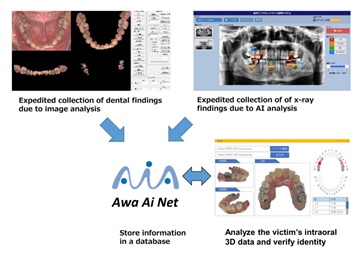
Figure 4: Overall view of our plan.
COOPERATION WITH NEIGHBORING PREFECTURES
Tokushima Prefecture, where we live, is adjacent to Kochi Prefecture and Wakayama Prefecture via the sea. If a corpse is washed away by a tsunami, there is a high possibility that the bodies of mutual citizens will flow to neighboring prefectures. For this reason, a collaborative / cooperative system that can make inquiries to neighboring prefectures is also necessary for identity verification. In our region, it will be necessary to construct an identity confirmation network in cooperation with Awa Ai Net in Tokushima Prefecture, Kochi EHR Net being built in Kochi Prefecture, and Seishu-Link in Wakayama Prefecture (Figure 5). However, there are 2,000 personal information protection systems (P2K Problem) in Japan [8]. This is because local governments such as prefectures and municipalities throughout the country have established regulations for the protection of personal information, etc., and rules such as different definitions of personal information become barriers, and data is transmitted across regions. It is a problem that cannot be used. Therefore, legal maintenance will be required in the future.
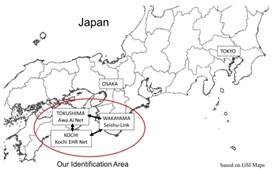
Figure 5: Cooperation.
CONCLUSION
Japan is one of the most earthquake-prone countries in the world. In the near future, the occurrence of a major earthquake that will cause the most casualties in the history of Japan is expected. Prompt identification after the disaster will contribute to reducing the sadness of survivors and early recovery from earthquakes. About 10 years have passed since the Great East Japan Earthquake, Information technology has progressed. Using these technologies, Japan will face an unprecedented disaster. I think this initiative will be useful for other countries.
REFERENCES
- Komuro T, Tsutsumi H, Izawa H, Katsumura S, Saitoh H, et al. (2019) Social contribution of forensic odontology in Japan. Jpn Dent Sci Rev 55: 121-125.
- Utsuno H (2019) Victim identification in large-scale disasters using dental findings. IATSS Research 43: 90-96.
- Police Countermeasures and Damage Situation associated with 2011Tohoku district (2019) National Police Agency of Japan.
- Aoki T, Ito K, Aoyama S, Kosuge E (2013) Disaster Victim Identification Using Dental Records-Experience of the Great East Japan Earthquake. IEEE Region 10 Humanitarian Technology Conference.
- Takano H, Kenji Terada K, Momota Y (2019) The development of personal identification method by image analysis technology of dentition. Impact 7: 64-66.
- Kuroda H, Inoue K, Takayama S, Ishii T, (2017) A Victim of the Great East Japan Earthquake Identified with the Preserved Medical Samples of Her Deceased Mother. Tohoku J Exp Med 242: 247-249.
- Ido K, Nakamura N, Nakayama M (2019) Miyagi Medical and Welfare Information Network: A Backup System for Patient Clinical Information after the Great East Japan Earthquake and Tsunami. Tohoku J Exp Med 248: 19-25.
- The Significance and the Analysis of the Problem Posed by 2,000 Personal Information Protection Systems; Toward the Adjustment of the PIP System of Local Government (2017). The journal of the study of modern society and culture 12: 105-121.
Citation: Takano H, Momota Y, Ozaki T, Shiozawa S, Terada K (2019) Personal Identification from Dental Findings Using AI and Image Analysis against Great Disaster in Japan. Forensic Leg Investig Sci 5: 041.
Copyright: © 2019 Takano H, et al. This is an open-access article distributed under the terms of the Creative Commons Attribution License, which permits unrestricted use, distribution, and reproduction in any medium, provided the original author and source are credited.

